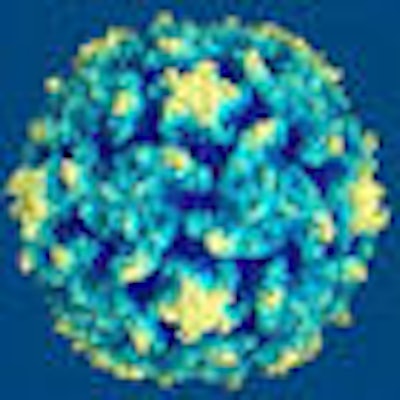
Herpesviruses have long been considered the culprits behind many oral diseases. Now a new study has found a link between endodontic disease and the Epstein-Barr virus. The discovery could lead to the development of new preventive and therapeutic treatments for some endodontic diseases.
Epstein-Barr is a form of herpesvirus and a pathogen found in more than 90% of the world's population. It is associated with many diseases, including infectious mononucleosis, malignant lymphomas, and nasopharyngeal carcinoma.
The new study has found that a large number of dental patients with the inflammatory diseases irreversible pulpitis and apical periodontitis also have the Epstein-Barr virus (Journal of Endodontics, December 2008, Vol. 34:12).
Researchers at the Oregon Health & Science University School of Dentistry wrote that their aim was to ascertain the presence of human cytomegalovirus (HCMV), Epstein-Barr virus (EBV), herpes simplex virus 1 (HSV-1), and varicella zoster virus (VZV) in endodontic pathoses. All four forms belong to three different groups of herpesvirus.
The team looked at specimens collected from 19 healthy pulp control patients and 82 patients exhibiting endodontic disease, including those with irreversible pulpitis or apical periodontitis, as well previously treated apical periodontitis. The patients' ages ranged from 15 to 92, with 50 males and 51 females. Specimens were obtained from molars, bicuspids, and anterior teeth.
Researchers studied the DNA and RNA from the specimens to determine the presence of herpesviruses.
EBV DNA was present in patients with endodontic disease in higher percentages (43.9%) compared to the control group (0%), as was EBV RNA (25.6% compared to 0%).
HCMV DNA and RNA were found in high percentages in both endodontic patients (15.9% and 29.3%, respectively) and in healthy controls (42.1% and 10.5%, respectively).
HSV-1 DNA was found in a slightly higher percentage of endodontic patients (13.4%) when compared to healthy controls (5.3%), but these differences were not statistically significant, according to the researchers. No HSV-1 RNA was found in any of the diseased or healthy pulp specimens. Only one patient, exhibiting symptomatic irreversible pulpitis, showed presence of VZV DNA and RNA.
"Our results have indicated that EBV is present in significantly higher frequencies in irreversible pulpitis and apical periodontitis when compared with healthy controls," the authors wrote. "This study supports the premise that EBV, but not HCMV, HSV-1, or VZV, is associated with irreversible pulpitis and apical periodontitis, and may potentially play a role in endodontic disease."
"There have been few prior publications on herpesviruses and endodontic disease -- only one other to my knowledge," said co-author Curtis Machida, Ph.D., a professor in the department of integrative biosciences at the Oregon Health & Science University, in an interview with DrBicuspid.com. "This current study is the first published report linking Epstein-Barr virus and irreversible pulpitis, one prominent form of endodontic disease."
Although the study has statistically significant evidence to prove that the presence of EBV is associated with endodontic pathoses, the fact that it is not found in all endodontic patients allows the interpretation that other microorganisms may serve as co-factors of disease, the researchers noted.
"EBV may represent one important player of irreversible pulpitis, but there are undoubtedly additional co-factors for disease," Machida said. "Endodontic disease is believed to be due to a polymicrobial infection and inflammatory disease. Knowing the full cast of players would obviously and ultimately lead to better and more targeted modes of therapy."
Machida added that the study has been of great interest to academics and professionals within the endodontic field.
Dennis Walling, M.D., an associate professor in the department of microbiology and immunology at the University of Texas Medical Branch, agreed that this is the first study to identify EBV specifically as the herpesvirus associated with endodontic disease. While previous research has linked herpesviruses with endodontic disease, this study extends and strengthens the association with the large number of histologically varied specimens that were studied, he noted.
"The potential significance of finding herpesviruses in periodontal and endodontal diseases is that it forces us to rethink long-held assumptions about the pathogenesis of these diseases originally believed to involve only bacteria," Dr. Walling said. "The interesting idea is that the viruses may act in a way that facilitates bacterial pathogenic potential, perhaps by compromising the local oral defense mechanisms in a way that shifts the host-microbe equilibrium in favor of the resident oral bacteria."
More research is needed to understand the mechanisms, which could lead to the eventual development of new preventive or therapeutic approaches to these diseases.
"However, this area of study still has far too many unanswered questions for anyone to yet know how this finding might be clinically useful," Dr. Walling concluded.



















